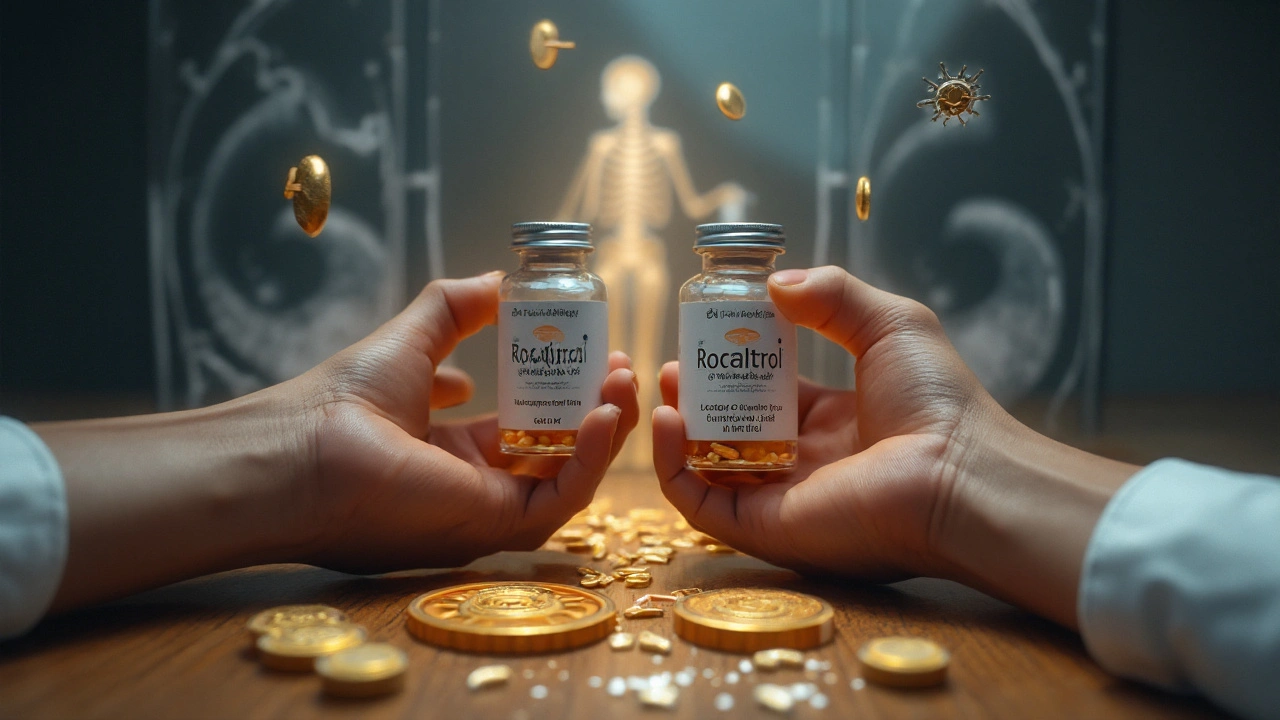
Vitamin D Analog Selector
Rocaltrol is a synthetic active form of vitamin D (calcitriol) that directly binds to the vitamin D receptor, helping regulate calcium and phosphate metabolism. It is most commonly prescribed for patients with chronic kidney disease (CKD) and hypocalcaemia. Because it bypasses the kidney’s conversion step, Rocaltrol works even when renal function is severely reduced.
Key Takeaways
- Rocaltrol delivers active vitamin D without needing kidney activation.
- Alternatives like alfacalcidol, doxercalciferol, and paricalcitol differ in activation pathways and side‑effect profiles.
- Cost and dosing frequency vary widely; generic calcitriol is often cheaper but may lack brand‑specific support.
- Choosing the right analog depends on CKD stage, calcium‑phosphate goals, and patient tolerance.
- Regular monitoring of serum calcium, phosphate, and PTH is essential for any active vitamin D therapy.
How Rocaltrol Works
When calcitriol (1,25‑dihydroxyvitamin D3) binds to the intracellular vitamin D receptor (VDR), it triggers transcription of calcium‑binding proteins, enhancing intestinal calcium absorption and suppressing parathyroid hormone (PTH) secretion. In CKD, the kidneys lose the ability to convert cholecalciferol to calcitriol, leading to secondary hyperparathyroidism (SHP). Rocaltrol restores the missing hormone, correcting the biochemical imbalance.
Major Alternatives at a Glance
Besides Rocaltrol, clinicians have several other vitamin D analogs to consider. Each has a distinct activation requirement, half‑life, and safety margin.
Alfacalcidol is a vitamin D3 derivative that needs only hepatic 25‑hydroxylation to become active. It is useful when liver function is intact but renal conversion is compromised.
Doxercalciferol is a synthetic 1‑hydroxyvitamin D2 that requires liver conversion to the active 1,25‑dihydroxy form. It is popular in the United States for dialysis patients.
Paricalcitol is a selective vitamin D receptor activator designed to lower PTH with reduced calcium‑phosphate absorption. It often suits patients prone to hypercalcaemia.
Vitamin D3 (cholecalciferol) is the natural precursor obtained from sunlight and diet, requiring two hydroxylations (liver then kidney) to become active. It is inexpensive but ineffective in advanced CKD without supplemental active analogs.
Comparison Table
| Analog | Activation Site | Typical Dose Frequency | Renal Clearance | Risk of Hypercalcaemia | Typical Cost (AU$ per month) |
|---|---|---|---|---|---|
| Rocaltrol (calcitriol) | Directly active (no conversion) | Daily or thrice weekly | Minimal; excreted hepatically | Moderate - requires tight monitoring | ≈ 80‑120 |
| Alfacalcidol | Liver 25‑hydroxylation only | Daily | Low | Low‑moderate | ≈ 70‑100 |
| Doxercalciferol | Liver 25‑hydroxylation only (vitamin D2 backbone) | Three times weekly | Low | Low‑moderate | ≈ 90‑130 |
| Paricalcitol | Directly active ( selective VDR agonist ) | Three times weekly | Renal‑dependent but less than calcitriol | Low - designed to limit calcium rise | ≈ 120‑180 |
| Vitamin D3 (cholecalciferol) | Liver then kidney hydroxylations | Daily | High - requires functional kidneys | Very low in CKD (ineffective) | ≈ 10‑30 |

Clinical Considerations
Understanding the patient’s underlying condition is crucial before picking an analog.
- CKD Stage 3‑5: Kidney conversion is impaired; direct‑acting agents like Rocaltrol, alfacalcidol, doxercalciferol, or paricalcitol are preferred.
- Risk of Hypercalcaemia: Patients with high baseline calcium or low bone turnover benefit from paricalcitol’s selective profile.
- Hepatic Function: Severe liver disease may limit alfacalcidol or doxercalciferol, making Rocaltrol a safer bet.
- Cost Sensitivity: Generic calcitriol (Rocaltrol) often offers the best price‑performance ratio, especially when insurance coverage is limited.
- Dialysis Status: In haemodialysis, thrice‑weekly dosing of doxercalciferol or paricalcitol aligns with treatment visits, improving adherence.
Choosing the Right Analog - A Decision Guide
Below is a quick rule‑of‑thumb flow you can follow during a clinic visit.
- Assess renal function (eGFR). If eGFR < 30mL/min, avoid relying on vitamin D3 alone.
- Check serum calcium and phosphate. If calcium is already high, lean toward paricalcitol or a lower dose of alfacalcidol.
- Evaluate liver health. Significant hepatic impairment pushes you toward Rocaltrol.
- Consider dosing convenience. Daily pill burden may favour Rocaltrol; thrice‑weekly injections could be arranged for doxercalciferol.
- Factor in cost and insurance coverage. Generic calcitriol is usually the most affordable.
Applying this framework helps you match the drug’s pharmacology to the patient’s biochemistry, reducing trial‑and‑error.
Related Concepts
These topics often appear alongside discussions of active vitamin D therapy.
- Secondary hyperparathyroidism (SHP) a compensatory rise in PTH due to low calcium and vitamin D activity in CKD
- Chronic kidney disease (CKD) a progressive loss of renal function that disrupts mineral metabolism
- Calcium‑phosphate product the multiplied serum levels of calcium and phosphate, a predictor of vascular calcification
- Vitamin D receptor (VDR) a nuclear receptor that mediates the effects of active vitamin D on gene expression
- Bone turnover markers biomarkers like osteocalcin that reflect bone formation and resorption rates
Next Steps for Patients and Clinicians
After selecting an analog, implement a monitoring schedule:
- Baseline: serum calcium, phosphate, PTH, alkaline phosphatase.
- Week 2: repeat calcium and phosphate; adjust dose if >2.6mmol/L calcium.
- Month 1 and quarterly thereafter: full mineral panel plus bone turnover markers if osteoporosis risk is high.
Document any adverse events, especially symptoms of hypercalcaemia (nausea, polyuria, confusion). Adjust therapy promptly.
Frequently Asked Questions
What is the main difference between Rocaltrol and vitamin D3?
Rocaltrol (calcitriol) is the hormonally active form of vitamin D, while vitamin D3 (cholecalciferol) is a precursor that needs two hydroxylations-first in the liver, then in the kidneys-to become active. In advanced CKD, the kidney step fails, making Rocaltrol the effective choice.
When should I consider paricalcitol over Rocaltrol?
Paricalcitol is useful when a patient shows signs of hypercalcaemia or hyperphosphataemia despite standard dosing. Its selective VDR activation suppresses PTH with less intestinal calcium absorption, reducing the risk of calcium spikes.
Is alfacalcidol safer for patients with liver disease?
Alfacalcidol relies on hepatic 25‑hydroxylation but not renal conversion, so it works well if the liver is functional. In severe liver impairment, its activation may be insufficient, making direct‑acting calcitriol a better option.
How often do I need to monitor labs after starting an active vitamin D analog?
Check calcium and phosphate within two weeks of initiation, then at one month, and subsequently every three months. If levels rise rapidly, shorten the interval and adjust the dose.
Can I use over‑the‑counter vitamin D supplements alongside Rocaltrol?
Generally avoid extra vitamin D3 supplements because they can push calcium higher and negate the precise control you get with Rocaltrol. If additional supplementation is needed, it must be under strict medical supervision.

Marie Green
September 25, 2025 AT 06:45Sounds like a solid overview for clinicians.
TOM PAUL
September 25, 2025 AT 13:33Great job breaking down the activation pathways.
I like how the flowchart matches real‑world decision making.
For patients on dialysis, the thrice‑weekly dosing really aligns with their schedule.
The cost comparison is spot on, especially for those without generous insurance.
Remember to check calcium levels before bumping the dose.
Overall, this guide makes the choices feel less intimidating.
Ash Charles
September 25, 2025 AT 20:30Stop overthinking it-if the liver’s fine, go straight to calcitriol. The data shows it kicks in faster and avoids the extra conversion step. Don’t waste time with alfacalcidol when you can give the active form now. Keep monitoring, but act decisively.
Michael GOUFIER
September 26, 2025 AT 03:26The exposition exhibits commendable thoroughness and precise articulation of pharmacokinetic distinctions. It is advisable for practitioners to integrate the presented algorithm into routine assessment of mineral metabolism disorders. Adherence to the recommended laboratory monitoring schedule will mitigate the risk of hypercalcaemia. Furthermore, consideration of patient‑specific factors such as hepatic function and economic constraints aligns with evidence‑based practice. I concur with the emphasis on individualized therapy.
michael Mc Laughlin
September 26, 2025 AT 10:23This is super useful. I’ll definitely share it with my clinic buddies.
Luke Schoknceht
September 26, 2025 AT 17:20Let me tell you why most of the hype around these vitamin D analogs is nothing but smoke and mirrors.
First, the pharmaceutical industry loves to dress up a cheap molecule like calcitriol with a flashy brand name and a premium price tag.
Second, the so‑called ‘selective VDR activators’ are just clever marketing jargon designed to make doctors feel they’re prescribing something exotic.
Third, the clinical trials that glorify paricalcitol often have hidden endpoints that favor the sponsor’s agenda.
Fourth, the real culprit for patient outcomes is not the analog you pick but how rigorously you monitor calcium, phosphate, and PTH.
Fifth, the cost savings you brag about with generic calcitriol evaporate when you factor in frequent lab draws and hospitalizations from missed hypercalcaemia.
Sixth, the dosing frequency myths-daily versus thrice‑weekly-are irrelevant if the patient cannot adhere.
Seventh, the tables you provided are useful, but they ignore the heterogeneity of the CKD population.
Eighth, liver dysfunction isn’t a binary switch; it’s a spectrum that demands nuanced dosing.
Ninth, the claim that alfacalcidol is ‘low‑moderate risk’ is oversimplified, as case reports of severe hypercalcaemia exist.
Tenth, the notion that vitamin D3 is useless in CKD ignores emerging data on extra‑renal synthesis.
Eleventh, you forgot to mention the interplay with fibroblast growth factor‑23, a key regulator that can blunt the effectiveness of any analog.
Twelfth, the patient’s dietary calcium intake can swing the balance just as much as the drug choice.
Thirteenth, you ought to stress shared decision‑making, because no algorithm can replace a good conversation.
Fourteenth, the real takeaway is that clinicians need to be skeptical of packaged solutions and focus on individualized care.
Finally, if you’re looking for a one‑size‑fits‑all answer, you’ll be disappointed; medicine is messy, and these analogs are merely tools, not miracles.
mauricio gonzalez martinez
September 27, 2025 AT 00:16Got it, but the practical side matters too.
Christian Freeman
September 27, 2025 AT 07:13The interplay of biochemistry and patient experience reminds us that medicine is as much art as science, and these choices reflect that balance.
julie shayla
September 27, 2025 AT 14:10Oh sure, because adding philosophy magically fixes hypercalcaemia.
Super Mom
September 27, 2025 AT 21:06For anyone starting out, remember to start low and go slow with calcitriol-dose titration is key to avoiding spikes in calcium. Also, keep an eye on PTH trends; a steady decline indicates you’re on the right track.
Jean Tredoux
September 28, 2025 AT 04:03Don’t trust the pharma‑backed dosing tables; they hide the real side effects to keep profits high.
cedric Gicquiaud
September 28, 2025 AT 11:00The data is out there if you look beyond the press releases; independent studies show alternative dosing can be safer.
Mason Grandusky
September 28, 2025 AT 17:56All in all, the best analog is the one that fits the patient’s lifestyle, labs, and wallet-no single drug rules the kingdom.